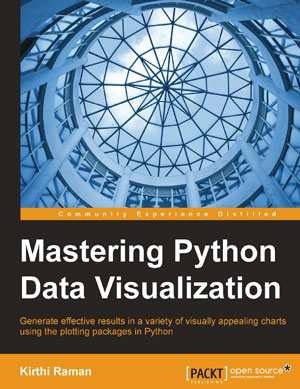
出版时间:2015.10
官网链接:Packt
下载地址:百度网盘(PDF+EPUB)
内容简介:
Book Description
Python has a handful of open source libraries for numerical computations involving optimization, linear algebra, integration, interpolation, and other special functions using array objects, machine learning, data mining, and plotting. Pandas have a productive environment for data analysis. These libraries have a specific purpose and play an important role in the research into diverse domains including economics, finance, biological sciences, social science, health care, and many more. The variety of tools and approaches available within Python community is stunning, and can bolster and enhance visual story experiences.
This book offers practical guidance to help you on the journey to effective data visualization. Commencing with a chapter on the data framework, which explains the transformation of data into information and eventually knowledge, this book subsequently covers the complete visualization process using the most popular Python libraries with working examples. You will learn the usage of Numpy, Scipy, IPython, MatPlotLib, Pandas, Patsy, and Scikit-Learn with a focus on generating results that can be visualized in many different ways. Further chapters are aimed at not only showing advanced techniques such as interactive plotting; numerical, graphical linear, and non-linear regression; clustering and classification, but also in helping you understand the aesthetics and best practices of data visualization. The book concludes with interesting examples such as social networks, directed graph examples in real-life, data structures appropriate for these problems, and network analysis.
By the end of this book, you will be able to effectively solve a broad set of data analysis problems.
What You Will Learn
- Gather, cleanse, access, and map data to a visual framework
- Recognize which visualization method is applicable and learn best practices for data visualization
- Get acquainted with reader-driven narratives and author-driven narratives and the principles of perception
- Understand why Python is an effective tool to be used for numerical computation much like MATLAB, and explore some interesting data structures that come with it
- Explore with various visualization choices how Python can be very useful in computation in the field of finance and statistics
- Get to know why Python is the second choice after Java, and is used frequently in the field of machine learning
- Compare Python with other visualization approaches using Julia and a JavaScript-based framework such as D3.js
- Discover how Python can be used in conjunction with NoSQL such as Hive to produce results efficiently in a distributed environment
Authors
Kirthi Raman is currently working as a lead data engineer with Neustar Inc, based in Mclean, Virginia USA. Kirthi has worked on data visualization, with a focus on JavaScript, Python, R, and Java, and is a distinguished engineer. Previously, he worked as a principle architect, data analyst, and information retrieval specialist at Quotient, Inc. Kirthi has also worked as a technical lead and manager for a start-up.
He has taught discrete mathematics and computer science for several years. Kirthi has a graduate degree in mathematics and computer science from IIT Delhi and an MS in computer science from the University of Maryland. He has written several white papers on data analysis and big data.